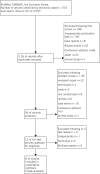Prophylactic mesh use during primary stoma formation to prevent parastomal hernia
- PMID: 27269439
- PMCID: PMC5392779
- DOI: 10.1308/rcsann.2016.0186
Prophylactic mesh use during primary stoma formation to prevent parastomal hernia
Abstract
Introduction Parastomal hernia (PSH) is a common problem following stoma formation. The optimal technique for stoma formation is unknown although recent studies have focused on whether placement of prophylactic mesh at stoma formation can reduce PSH rates. The aim of this study was to systematically review use of prophylactic mesh versus no mesh with regard to occurrence of PSH and peristomal complications. Methods A systematic search was performed using PubMed, Embase™ and the Cochrane Library to identify randomised controlled trials that analysed placement of prophylactic mesh versus no mesh at time of initial surgery. Meta-analysis was performed using random effects methods. Results A total of 506 studies were identified by our search strategy. Of these, 8 studies were included, involving 430 patients (217 mesh vs 213 no mesh). Prophylactic mesh placement resulted in a significantly lower rate of PSH formation (42/217 [19.4%] vs 92/213 [43.2%]) with a combined risk ratio of 0.40 (95% confidence interval [CI]: 0.21-0.75, p=0.004). Placement of prophylactic mesh did not result in increased peristomal complications (15/218 [6.9%] vs 16/227 [7.0%]) with a combined risk ratio of 1.0 (95% CI: 0.49-2.01, p=0.990). Conclusions Prophylactic placement of mesh at primary stoma formation may reduce the incidence of PSH, without an increase in peristomal complications. However, the overall quality of the randomised controlled trials included in the meta-analysis was poor, and should prompt caution regarding the applicability of the findings of the individual studies and the meta-analysis to everyday practice.
Keywords: Mesh; Parastomal hernia; Prevention; Systematic review.
Figures







References
-
- Pearl RK. Parastomal hernias. World J Surg 1989; ; 569–572. - PubMed
-
- van Dijk SM, Timmermans L, Deerenberg EB et al. . Parastomal hernia: impact on quality of life? World J Surg 2015; : 2,595–2,601. - PubMed
-
- Ripoche J, Basurko C, Fabbro-Perray P, Prudhomme M. Parastomal hernia. A study of the French federation of ostomy patients. J Visc Surg 2011; ; e435–e441. - PubMed
-
- Shabbir J, Britton DC. Stoma complications: a literature overview. Colorectal Dis 2010; ; 958–964. - PubMed
-
- Hansson BM, Slater NJ, van der Velden AS et al. . Surgical techniques for parastomal hernia repair: a systematic review of the literature. Ann Surg 2012; ; 685–695. - PubMed
Publication types
MeSH terms
Grants and funding
LinkOut - more resources
Full Text Sources
Other Literature Sources

